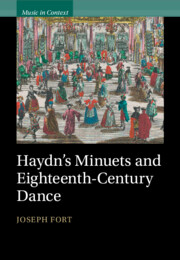Refine search
Actions for selected content:
64 results
7 - Hunger in Urban and Rural Areas, and Children on the Move
-
-
- Book:
- Hunger Redraws the Map
- Published online:
- 01 November 2025
- Print publication:
- 20 November 2025, pp 197-230
-
- Chapter
- Export citation
1 - The Dance Culture of Late Eighteenth-Century Vienna
-
- Book:
- Haydn's Minuets and Eighteenth-Century Dance
- Published online:
- 12 September 2025
- Print publication:
- 02 October 2025, pp 11-61
-
- Chapter
- Export citation
Introduction
-
- Book:
- Haydn's Minuets and Eighteenth-Century Dance
- Published online:
- 12 September 2025
- Print publication:
- 02 October 2025, pp 1-10
-
- Chapter
- Export citation

Haydn's Minuets and Eighteenth-Century Dance
-
- Published online:
- 12 September 2025
- Print publication:
- 02 October 2025
3 - Cities and Riverine Flooding
-
- Book:
- Legacy in the Landscape
- Published online:
- 11 November 2025
- Print publication:
- 11 September 2025, pp 30-61
-
- Chapter
- Export citation

Schoenberg in Context
-
- Published online:
- 04 September 2025
- Print publication:
- 04 September 2025
Chapter 15 - Money (and Mythos)
- from Part IV - Paradoxes and Predicaments
-
-
- Book:
- Schoenberg in Context
- Published online:
- 04 September 2025
- Print publication:
- 04 September 2025, pp 153-162
-
- Chapter
- Export citation
Chapter 32 - Poetry, Literature and Language
- from Part VIII - Ideas, Beliefs and Interventions
-
-
- Book:
- Schoenberg in Context
- Published online:
- 04 September 2025
- Print publication:
- 04 September 2025, pp 316-324
-
- Chapter
- Export citation
Chapter 28 - Music Criticism and Music Critics
- from Part VII - Performers and Critics
-
-
- Book:
- Schoenberg in Context
- Published online:
- 04 September 2025
- Print publication:
- 04 September 2025, pp 276-284
-
- Chapter
- Export citation
Chapter 2 - Vienna
- from Part I - Schoenberg in Place
-
-
- Book:
- Schoenberg in Context
- Published online:
- 04 September 2025
- Print publication:
- 04 September 2025, pp 10-17
-
- Chapter
- Export citation
15 - Exoticism, Race, and the Broadway Musical in the ‘City of Waltzes’
- from Part III - The Legacy
-
-
- Book:
- The Cambridge Companion to <i>West Side Story</i>
- Published online:
- 09 January 2025
- Print publication:
- 09 January 2025, pp 252-265
-
- Chapter
- Export citation
12 - Schubert and the Style Brillant: Variation and Figuration in Schubert’s Concertante Chamber Music with Piano
- from Part IV - Understanding Schubert’s Writing for the Piano
-
-
- Book:
- Schubert's Piano
- Published online:
- 31 August 2024
- Print publication:
- 17 October 2024, pp 241-258
-
- Chapter
- Export citation
5 - Schubert and the Viennese Piano
- from Part II - Instruments and Performance
-
-
- Book:
- Schubert's Piano
- Published online:
- 31 August 2024
- Print publication:
- 17 October 2024, pp 93-115
-
- Chapter
- Export citation
14 - Reflections and Echoes in Schubert’s Waltzes
- from Part IV - Understanding Schubert’s Writing for the Piano
-
-
- Book:
- Schubert's Piano
- Published online:
- 31 August 2024
- Print publication:
- 17 October 2024, pp 283-300
-
- Chapter
- Export citation
3 - The Piano in Schubert’s Lied Texts
- from Part I - The Piano in Schubert’s World
-
-
- Book:
- Schubert's Piano
- Published online:
- 31 August 2024
- Print publication:
- 17 October 2024, pp 50-69
-
- Chapter
- Export citation
15 - ‘Schubert Would Have No Objection if He Knew about It’: Franz Liszt’s Reception of Schubert’s Music
- from Part IV - Understanding Schubert’s Writing for the Piano
-
-
- Book:
- Schubert's Piano
- Published online:
- 31 August 2024
- Print publication:
- 17 October 2024, pp 301-323
-
- Chapter
- Export citation
1 - Franz Schubert as a Pianist
- from Part I - The Piano in Schubert’s World
-
-
- Book:
- Schubert's Piano
- Published online:
- 31 August 2024
- Print publication:
- 17 October 2024, pp 9-29
-
- Chapter
- Export citation
11 - Una Corda: Beethoven’s and Schubert’s Exploration of the Piano’s Sonority as a Structural Resource
- from Part III - Sound and Musical Imagery
-
-
- Book:
- Schubert's Piano
- Published online:
- 31 August 2024
- Print publication:
- 17 October 2024, pp 219-238
-
- Chapter
- Export citation
9 - The Piano and Musical Imagery in Schubert’s Lieder
- from Part III - Sound and Musical Imagery
-
-
- Book:
- Schubert's Piano
- Published online:
- 31 August 2024
- Print publication:
- 17 October 2024, pp 180-200
-
- Chapter
- Export citation
7 - Viennese Pianoforte Treatises as a Reflection of Schubert’s Pianistic Audience
- from Part II - Instruments and Performance
-
-
- Book:
- Schubert's Piano
- Published online:
- 31 August 2024
- Print publication:
- 17 October 2024, pp 136-158
-
- Chapter
- Export citation
